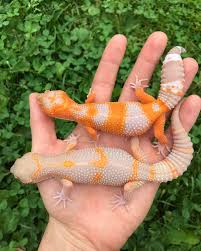GECKO LAVA BLACK NIGHT (Eublepharis macularius)
$500.00
Full Description
Here is a comprehensive care guide for the Lava Black Night Leopard Gecko (Eublepharis macularius), a selectively bred morph combining two visually stunning lineages: the ultra-dark Black Night and the deep red-orange Lava coloration.
Lava Black Night Leopard Gecko – Care Guide
Morph Overview
| Trait | Description |
|---|---|
| Morph Name | Lava Black Night |
| Lineage | Combination of: |
-
Black Night – selectively bred for extreme melanism (solid black or deep gray body)
-
Lava – line-bred for deep, vibrant orange/red hues |
| Type | Line-bred/polygenic traits; not tied to a single gene |
| Scientific Name | Eublepharis macularius |
| Experience Level | Intermediate (due to rarity & sensitivity to stress/light) |
Size & Lifespan
| Trait | Range |
|---|---|
| Adult Size | 8–10 inches (20–25 cm) |
| Weight | 50–90 grams |
| Lifespan | 15–20 years (in captivity) |
Enclosure Requirements
Enclosure Size
-
Juveniles: 10–20 gallon long tank
-
Adults: Minimum 20–40 gallon breeder (36″x18″) for adequate floor space
Substrate Options
| ✅ Safe | ❌ Unsafe |
|---|---|
| Paper towels | Calcium/loose sand |
| Slate or ceramic tile | Wood chips or bark |
| Bioactive soil (advanced) | Gravel, small particulate |
Essential Enclosure Features
| Item | Description |
|---|---|
| 3 hides | Warm, cool, and humid hides are necessary |
| Humid hide | Use sphagnum moss or moist eco-earth for shedding |
| Décor | Low branches, rocks, fake plants for enrichment |
| Water dish | Clean, shallow, refreshed daily |
️ Temperature & Humidity
| Zone | Temperature (°F) | Temperature (°C) |
|---|---|---|
| Warm side | 88–92°F | 31–33°C |
| Cool side | 75–80°F | 24–27°C |
| Night min. | 68–72°F | 20–22°C |
| Humidity | 30–40% ambient, 70–80% in humid hide |
Heating Tips
-
Use an under-tank heater (UTH) on a thermostat
-
Monitor belly heat carefully — dark morphs like Lava Black Night absorb more radiant heat
-
Avoid high-wattage overhead basking bulbs
Lighting Considerations
-
UVB is optional but recommended (5% T5 linear or Arcadia ShadeDweller)
-
Avoid bright white overhead lights — Black Night morphs have dark eyes (often Eclipse-influenced) and may be light-sensitive
-
Provide hiding spots in shade to reduce stress
️ Diet & Nutrition
Feeder Insects
-
Staples:
-
Dubia roaches
-
Crickets
-
Mealworms (limited amounts)
-
Black soldier fly larvae
-
-
Treats:
-
Superworms
-
Waxworms (very occasionally)
-
Feeding Schedule
| Age | Frequency |
|---|---|
| Juvenile | Daily |
| Adult | Every 2–3 days |
Supplements
| Type | Frequency |
|---|---|
| Calcium (no D3) | Always available |
| Calcium + D3 | 1–2× per week |
| Multivitamin | 1× per week |
Gut-load all insects 24 hours before feeding.
Enclosure Maintenance
-
Daily: Remove waste, refresh water
-
Weekly: Replace paper towels or clean tile
-
Monthly: Full substrate refresh if loose or bioactive
-
Monitor for humidity in humid hide to support healthy shedding
Behavior & Handling
-
Generally calm and handleable
-
May be shy or reclusive due to light sensitivity (Black Night influence)
-
Best to handle during early evening or dusk
-
Limit early handling sessions to 5–10 minutes until trust builds
⚠️ Morph-Specific Notes
| Trait | Consideration |
|---|---|
| Light Sensitivity | Avoid bright or direct lights—dark morphs have Eclipse-like eyes that are more sensitive |
| Color Stability | Lava orange tones may fade in stressful or overly lit environments—low-stress, dim setup is ideal |
| Genetic Health | Avoid inbreeding (especially Black Night to Black Night); outcross for vigor |
| Heat Absorption | Monitor belly temps closely—dark pigmentation absorbs more heat than lighter morphs |
✅ Summary Checklist
-
✅ 20–40 gallon enclosure with horizontal floor space
-
✅ UTH with thermostat for belly heat
-
✅ Three hides: warm, cool, and humid
-
✅ Gut-loaded feeder insects + calcium/D3/vitamin supplementation
-
✅ Low-intensity lighting with shaded retreat areas
-
✅ Clean, non-loose substrate
-
✅ Monitor stress and provide enrichment

